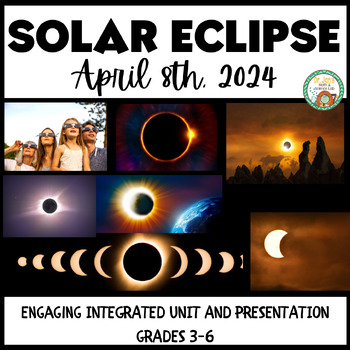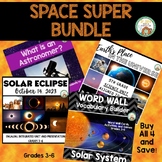Solar Eclipse 2024 Integrated Unit and Presentation (Print and Digital)
- Zip
What educators are saying
Also included in
- This AWESOME Super Bundle combines 4 separate resources with a Space Theme.Save a bunch by purchasing all of these products together. Each product is also available separately in my TpT store. Here's a summary of what's included in each: Earth's Place in the Universe:*Planet Report Pages*relativePrice $22.40Original Price $28.00Save $5.60
Description
This thematic unit is full of engaging and quality activities in all areas of curriculum to help students develop a strong conceptual understanding of solar eclipses, specifically the upcoming total solar eclipse on April 8th, 2024. This is such a unique opportunity for all! Get students exited about this upcoming event!
***Both a Print Version and a Digital Version for Google Classroom™ are included with this purchase.****
Activities included:
Activity 1: Solar Eclipse: Students read an informational passage and then answer questions.
Activity 2: Solar Eclipse Vocabulary: Definitions, word wall cards, and word wall activities.
Activity 3: Modeling a Solar Eclipse: Students use fruit and a flashlight to model how a solar eclipse occurs.
Activity 4: A Solar Eclipse Model: Another option for modeling a Total Solar Eclipse using everyday items.
Activity 5: Eclipse Foldable
Activity 6: Solar Eclipse Safety Poster: Students create a poster about the eclipse and safety precautions.
Activity 7: Making a Pin Hole Viewer: Students use a cardboard box to make a simple pinhole viewer.
Activity 8: Eclipse Myths Students read some eclipse myths from several cultures, and then use creativity to write and draw their own.
Activity 9: Elapsed Time: Students use an time table for this year’s eclipse to answer some questions regarding time.
Activity 10: The Path of Totality: Students read a map with the path of the upcoming total solar eclipse and answer questions.
Activity 11: Descriptive Writing: After viewing the eclipse, students write a descriptive essay.
Activity 12: Cinquain Poem: Students write a cinquain poem about an eclipse.
Activity 13: Optional Post Test and Grading Rubric
A presentation is also provided with this unit. The presentation provides content background on solar eclipses and helps explain this phenomena through colorful, interactive slides, embedded videos, and diagrams. Different kinds of eclipses are highlighted, and details on the upcoming total solar eclipse are shared. Notes for the teacher are included on just about every slide, and a notes page for students can be used as an assessment. The presentation is also in 2 formats; PowerPoint and google slides.
If you enjoy this download, please consider following my store. All new products are 50% off for the first 48 hours.
******Click Here to Download a FREE Science Research Report resource******
I also appreciate feedback, and you can earn TpT credits for future purchases.






